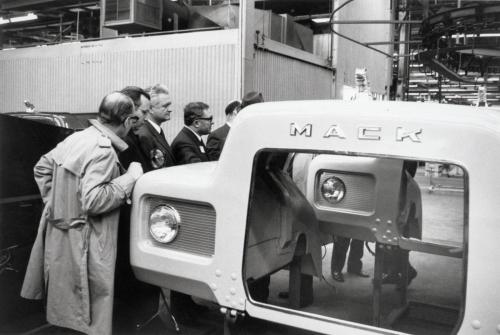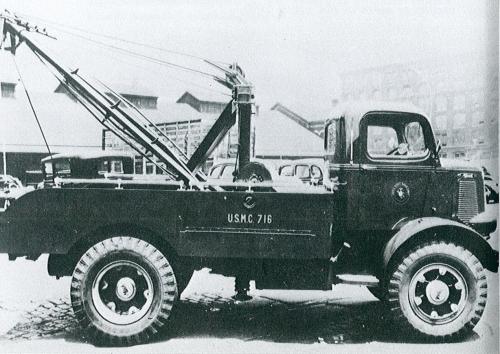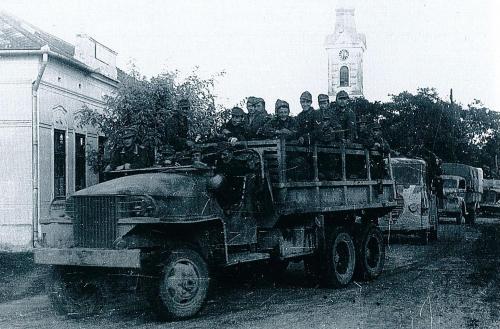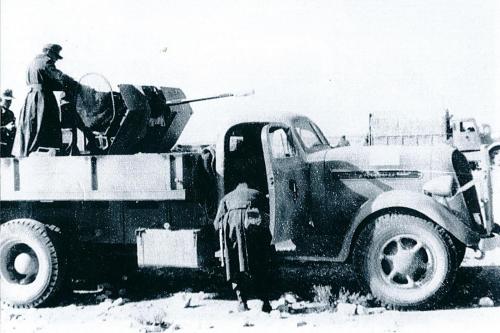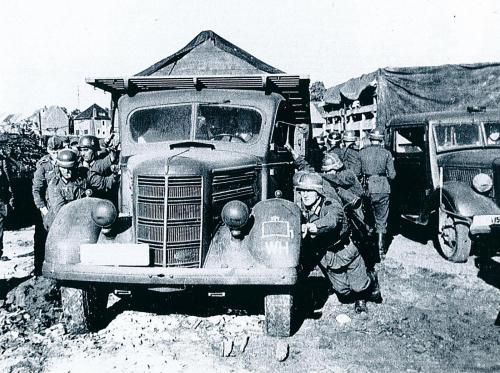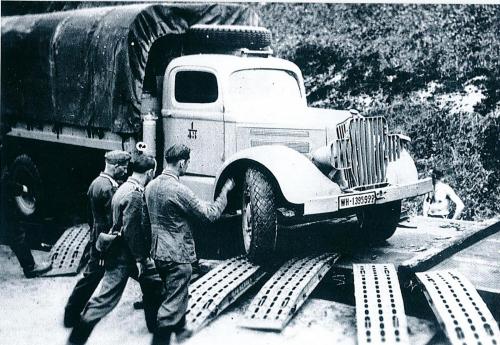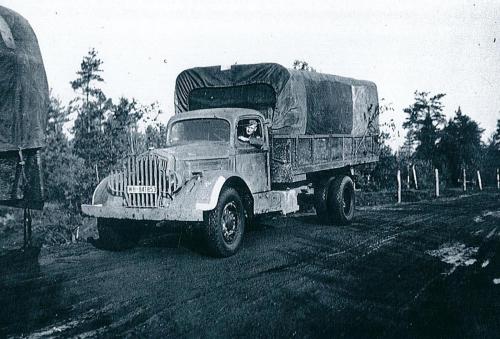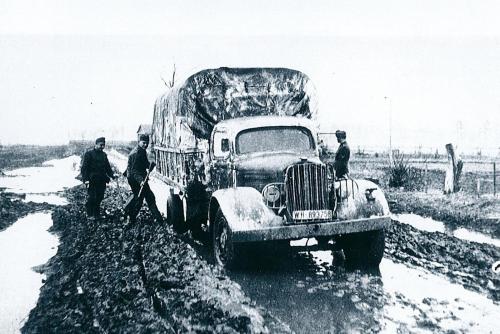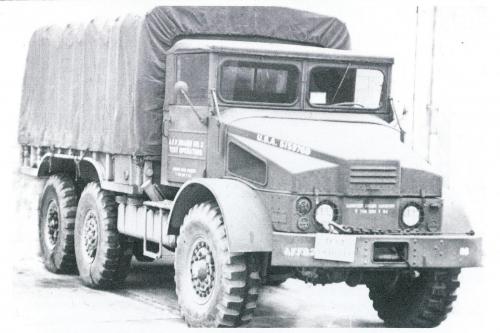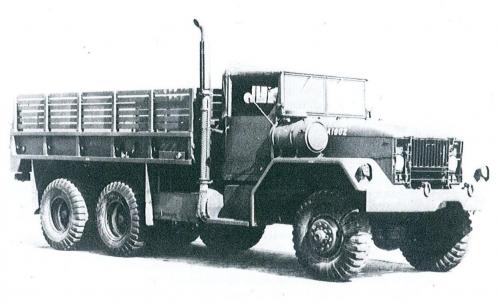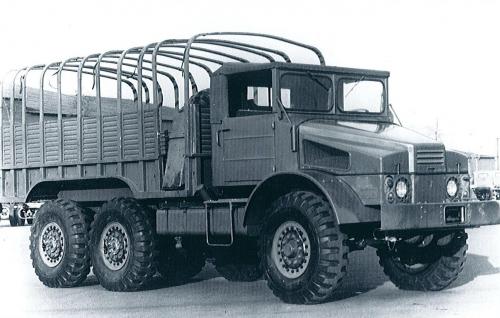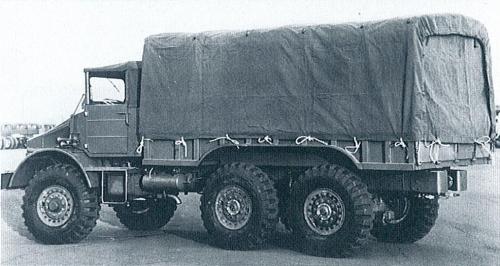
kscarbel
Pedigreed Bulldog-
Posts
1,114 -
Joined
-
Last visited
-
Days Won
8
Content Type
Profiles
Forums
Gallery
Events
Blogs
BMT Wiki
Collections
Store
Everything posted by kscarbel
-
Mack Military Truck ?
kscarbel replied to B61TENDT711's topic in Modern Mack Truck General Discussion
For those unfamiliar with what we're talking about, let me take a moment to explain. At the same time that Mack Trucks was achieving major sales success in Europe, the Middle East and Iran, the opening up of the Soviet Union presented a major opportunity for the company. It is ironic that, while politics prevented Mack Trucks from cooperating with Russia on the HUGE KamAZ truck plant project, many other U.S. companies were in the end allowed to participate, bringing them vast profits while giving the Russians their first state-of-the-art commercial truck production facility (see Summary below). Mack Trucks Signs Pact with Russia Business Week Magazine / June 18, 1971 The Soviet Union and Mack Trucks, Inc. have signed a $700 million preliminary agreement for the U.S. company to supply machinery and technology for a huge Russian truck manufacturing plant. The agreement is subject to approval by the U.S. government. It was signed by Zenon C.R. Hansen, chairman and president of Mack Trucks, and N.D. Komarov, Russian deputy foreign trade minister, May 18 at the company’s Allentown, PA headquarters. Hansen, commenting in a telephone interview, said he would describe the result of the talks with the Russians as a “letter of intent” rather than as a preliminary agreement. Hansen said that “with the changing attitudes on east-west trade,” he was enthusiastic about the prospects of government approval. The proposed deal could have a skyrocketing effect on U.S.-Russian trade. Total U.S. exports to Russia amounted to only $118 million in 1970. The Russians were reported to be clearing land for the $1.3 billion project near Naberezhnle Chelney, 600 miles east of Moscow in the Tartar Republic.The project was said to include housing for an eventual 300,000 people. The plant may require an estimated $1 billion worth of machinery and technology before it is completed. Export of Mack Trucks To Russia May Be Near SAN ANTONIO EXPRESS / August 10, 1971 (WASHINGTON) The Nixon administration approved licenses Monday for export of million worth of foundry equipment to the Soviet Union, apparently clearing the way for a massive trade deal involving Mack Trucks Inc. Although the two licenses approved went to a company other than Mack, a Commerce Department spokesman said the action was “related to the project on the Kama river” where the Allentown, Pa. firm proposes to build what is billed as the world's largest truck plant. Commerce officials said privately the action would be a first step in approval of the Mack Truck deal but said It should not be construed as meaning a final decision has been made. The department approved three licenses altogether, including one for export of technical data for iron and steel foundries. Equipment for automotive castings was among items listed. The firm went unidentified, in line with department policy. Roger Mullin, executive vice president of Mack Trucks, said the export licenses approved were “definitely not for us. Our application is for machine tools.” But he said foundry equipment would be necessary before a truck plant could be built. Mack Trucks signed an agreement with the Soviet government this spring to build the Kama River project. The Mack Trucks spokesman said the cost is just a guess, but he said estimates have run between $1 billion and $2 billion. Mack Trucks, as a result of the agreement, is seeking authority to export an estimated $700 million worth of machinery and technology to the Soviet Union. The company spokesman, asked whether the government’s action indicated the administration will act favorably on the entire deal, said he would not speculate on what would happen next. He said “your question would lead logically” to the conclusion the administration is looking on the application favorably. Mullin said in reference to the foundry equipment: “It is an essential part. We would have to have a foundry.” The government refuses to name the companies for which it approves export licenses. A spokesman said it only referred to the Kama River project because it had been previously announced by the parties involved. Officials said a step-by-step approval process may be used in granting licenses for the project. The Commerce Department’s Office of Export Control passes on specific export licenses for export of equipment forbidden under government regulations. Such high-technology items as foundry equipment are prohibited from being exported, unless a specific license is granted by the government. About a year ago, Henry Ford II went to Moscow in an attempt, later abandoned, to complete a similar agreement. At that time, Secretary of Defense Melvin R. Laird commented: “Before giving away the technology to construct trucks in the Soviet Union, and establishing plants for them, there should be some indication on the part of the Soviet Union that they are not going to continue sending trucks to North Vietnam by the shiploads for use on the Ho Chi Minh Trail.” There was no Defense Department comment on Monday’s action by the Commerce Department. Mack cancels Soviet Plant The Miami News / Sept 16, 1971 Mack Trucks, Inc. has cancelled plans to build the world’s largest truck plant in the Soviet Union. Mack said it has not received U.S. approval. Mack signed a preliminary agreement with Soviet officials last May 18, providing that the Allentown, Pa. firm would design and supply a major part of the Soviet Union’s $1.4 billion Kama River truck plant. The deal, Mack said, hinged on whether the White House was willing to ease its policy on exports to communist countries sufficiently to grant the necessary approval. The deadline for government approval under the tentative agreement was initially June 25, but the date had been extended to September 15. In a terse message to Soviet officials yesterday, Mack said, “Since approval from the U.S. government has not been received and the second extension....expired with the close of business today, we feel that to our mutual interest.....to consider said protocol terminated.” There has been no official statement from administration sources on the proposed deal. Defense Secretary Melvin Laird, however, has in the past decried the fact that the Russians are supplying trucks to North Vietnam. Mack countered the charge with the argument that a final agreement would have stipulated that the trucks be used only for industrial and agricultural purposes within the Soviet Union. The Kama River plant, about 600 miles east of Moscow, was scheduled to begin production in 1975, with a planned capacity of 150,000 heavy diesel trucks and 100,000 diesel engines annually. Mack Truck President Zenon C.R. Hansen was unavailable for comment on cancellation of the project. Summary The Kama River (KamAZ) truck plant was built. The project was financed by Chase Manhattan Bank and U.S. government loans. The modern plant, automated by IBM model 370 computers, was built to produce 150,000 trucks and 250,000 diesel engines annually. Awarded Contracts: Principal engineering contractor - Swindell-Dressler Co. (Pittsburgh, PA) - $50 million C.E. Cast Equipment (Cleveland, OH) - $35 million Holcroft & Co. (Livonia, MI) - $20 million Ingersoll-Rand (Rockford, IL) - $20 million National Engineering Co. (Chicago, IL) - $15 million -
Mack Military Truck ?
kscarbel replied to B61TENDT711's topic in Modern Mack Truck General Discussion
That's a Renault "Sherpa", designed, produced and sold by "Renault Trucks Defense". Not sure why Volvo Group is trying to pass it off as a Mack-branded product. It has an Americanized version of the French Caesar artillery system incorporating a 105mm howitzer. This French system has been given a U.S. style name - Hawkeye. -
Mack Military Truck ?
kscarbel replied to B61TENDT711's topic in Modern Mack Truck General Discussion
There were many impressive wreckers produced during the WW2 period from truck manufacturers including Biederman, Corbitt, Federal, Kenworth and Ward La France. However among them all, I think the Mack EHU wreckers sold to the U.S. Marine Corps in 1939 were the sharpest looking of the bunch. -
Mack Military Truck ?
kscarbel replied to B61TENDT711's topic in Modern Mack Truck General Discussion
The Wehrmacht did indeed use many captured Russian army trucks, and one was the Studebaker US6. Over 200,000 were built for Lend-Lease countries. It was declared "Limited Standard" by the US military. Basically, the US Army purchased GMCs, the US Navy and Marine Corps purchased International Harvesters, and Studebakers went to Lend-Lease Countries. Of the 200,000 US6s built, 150,000 were shipped to Russia. The two exceptions were US6s allocated to US Army engineering units that built the Burma Road, and the Alaska-Canada Highway (linking the 48 states to Alaska so as to reinforce Alaska - resulting from the Japanese capture of Kiska island and Attu island in the Aleutians). Here's a picture of a Wehrmacht unit operating a captured American Studebaker US6 in Hungary in 1944, followed by a Peugeot and a German Ford (Ford-Werke AG produced over 20,000 vehicles in Germany for the German military during WW2). The Germans also operated many American Studebaker K25s captured from the French army. France had purchased 2,000 units in 1939. Here's a picture of one of these rugged trucks fitted with a 2cm anti-aircraft gun, operating in Libya in December 1941. -
Mack Military Truck ?
kscarbel replied to B61TENDT711's topic in Modern Mack Truck General Discussion
Here's something you don't see every day. During the war, the German army (Wehrmacht) operated thousands of captured trucks from various countries. This is a photograph of a captured Mack E model (EE, EF or EG?) in service with the 216th Engineering Battalion in 1940 somewhere in Belgium. I don't know if it came from the defeated Belgian army, French army or retreating British Expeditionary Force. Similarly, the French had purchased 1,500 model 704S 3-ton Whites in 1939 which were captured and put to work by the Wehrmacht (as shown below). -
Mack Military Truck ?
kscarbel replied to B61TENDT711's topic in Modern Mack Truck General Discussion
Here's a Mack 5-ton tactical cargo that many are probably unaware of. ________________________________________________________ The Mack T54 5-ton cargo prototype When the U.S. Army began developing their new 6x6 fleet during the 1948-1950 period, GMC’s T51 concept was selected for the 2-1/2 ton category, and Mack Trucks was chosen to produce a prototype in the 5-ton range resulting in the T54. The Mack T54 was also tested alongside the 5-ton XM41 developed by International. The Mack T54 used the same 250 horsepower air-cooled opposed-piston 8-cylinder Continental OA 536-1 engine as the GMC T51. However, whereas GMC T51’s opposed piston engine was mounted with its crankshaft in a vertical position (driving down and back to a semi-automatic Allison TT-270-1 3-speed planetary transmission and single-speed transfer case), the engine in the Mack T54 was mounted conventionally with the crankshaft in a horizontal position. The Mack T54 used the same Allison transmission and single-speed transfer case Work on the T54 began in 1947 and was suspended in 1953. Two prototypes were built. One had an aluminum cargo body and weighed in at 18,450 pounds, while the other had a steel cargo body and weighed 19,600 pounds. Both had aluminum cabs. The flat engine configuration and lack of a radiator allowed for a sloped engine hood providing superb visibility. The front axle featured a torsion bar independent suspension, while the rear bogie utilized a leaf spring and walking beam suspension. A central tire inflation was installed, mounted on the inside of the wheels, controllable from inside the cab. A 20,000 pound capacity Tulsa model 24 winch was mounted in the front, and a 2,000 pound capacity Anthony hydraulic tailgate was fitted. In the end, the army abandoned the expensive advanced design of the Mack and GMC prototypes, including opposed cylinder air-cooled engines, independent torsion bar front suspension, sealed brakes and aluminum bodies in favor of the lower cost conventionally designed M41 (single rear tire) and M50 series (dual rear tire). The M41 cargo was produced by International and Diamond T, while the M51 dump, M52 tractor and M54 cargo were also produced by Mack Trucks. The A1 versions (e.g. M54A1) featured a turbocharged Mack ENDT-673 (205hp@2,100rpm) diesel engine in lieu of the standard Continental R-6602 (224hp@2,800rpm) gasoline engine, and were easily distinguished by their vertical exhaust and large externally-mounted (right-side fender) air cleaner. Specifications - Mack T54 prototype: Engine: 250hp Continental OA 536-1 air-cooled opposed-piston 8-cylinder Displacement: 537.6 cu.in. Power: 250hp @ 3,000rpm Ignition: Magneto Transmission: Allison TT-270-1 semi-automatic 3-speed planetary transmission Transfer case: single speed Tires: 14.00x20 Top speed: 50 mph Cruise range: 300 miles (on 75 gallons of gasoline) Length: 23 feet 10.5 inches Height: 122 inches (reducible to 88.5 inches) Width: 96 inches Wheelbase: 155 inches Approach angle: 35º Departure angle: 40º -
These are the correct numbers. Trust me (35 years at Mack). There was only one B-model green from beginning to end. I'm sure no Mack dealer stocks it now. For many years, Kirker Chemical would still produce it for Mack dealers but they has a minimim order quantity. Pfahl Mack Restorations might have some to sell you, but in gallons.
-
Mack Christmas Cards
kscarbel replied to Bumblebee090458's topic in Antique and Classic Mack Trucks General Discussion
This is all I can find. Robert Evan's used to call his company Evans, Ect. and he was based in Hellertown, PA. http://www.macktruck...aspx?pageid=170 -
Chicago R models
kscarbel replied to Lmackattack's topic in Antique and Classic Mack Trucks General Discussion
A rare Macungie-built RD "Western Contractor" (the Value-Liner replacement). -
34k to 44k camelback
kscarbel replied to Lmackattack's topic in Modern Mack Truck General Discussion
Does your 85' have a transverse torque rod? Back in the 80's, Mack recalled the early rubber-bushed 44 rear trucks and installed transverse torque rods (1RY48P23). There was a pink Product Improvement Bulletin on that. If you're lacking it, you'd appreciate adding it. SS440 (fabricated axle housing like 34s and 38s) came with rubber trunnion bushings. Bronze bushings were optional. SS441 (cast axle housing) came with bronze bushing. Rubber trunnion bushings were optional, but only recommended for weight sensitive applications) -
34k to 44k camelback
kscarbel replied to Lmackattack's topic in Modern Mack Truck General Discussion
Unless you plan to add a transverse torque rod, go with the 38,000lb anti-sway / 44,000 standard 4QK4003A. If you go with the 44,000 anti-sway 4QK4005, you absolutely need to add a transverse torque rod (There's a Mack service bulletin on how to do it). Having said that, adding a transverse torque rod during your upgrade to 4QK4003 springs would dramatically extend the life of your trunnion insulators. And again, make sure you go with Mack urethane trunnion insulators (10QK276) and lower spring pads (10QK388). -
34k to 44k camelback
kscarbel replied to Lmackattack's topic in Modern Mack Truck General Discussion
Your best option is to upgrade your 34,000lb suspension to 38,000lb. You'll notice a significant difference. There's a Mack service bulletin that tells you how to do it. I'd also recommend you use Mack urethane trunnion insulators (10QK276) and lower spring pads (10QK388). Also, in the course of this upgrade, you could opt for the Mack 38,000lb "anti-sway" rear spring in lieu of the standard 38 rear spring. It's close to a 44,000 spring in capacity and was designed for loggers and other high center of gravity applications. -
MH's produced in 1984 (first year initial production) had 2-valve engines. Production from 1985-on had 4-engines. The MH went through a lot of last minute tweaking during 1984. From 1985 on, it was smooth sailing. The 1985 4vh 350's I sold were, understandably, much better performers than the 1984 MH's with 2vh 350's.Some FYI about late model 2VH engines. In 1988, the 2VH EM6-275L was the standard engine in the DMM-600S and DMM-6006S because that model had not been designed to accomodate chassis mounted charge-air cooling (CMCAC). The 2VH E6-350 (governed at 1950rpm rather than the 4VH's 1800rpm) was the optional engine in the DMM.
-
I hear you. But again, your past experience was with the first generation UltraShift DM3 (which used a centrifugal type clutch that engaged via engine speed). The current UltraShift Plus is an entirely different animal. Eaton made a mistake by not giving the current product a new name, to clearly differentiate it from the earlier DM3. The UltraShift Plus compares head on with the Mack mDrive (rebadged Volvo I-Shift). And, unlike the single countershaft I-Shift (one reason it's not approved for vocational applications), Eaton utilizes the more durable twin-countershaft design (just as ZF does).
-
The salaries of employees at any truck plant in the US indeed benefit the local economies. Navistar and Paccar pay corporate level taxes to the United States because they are incorporated in the United States (They are American companies). Volvo is incorporated in Sweden and pays Swedish corporate income taxes (note Volvo Group's Annual Report). Net profits from Volvo Group's US business units, including Volvo Trucks North America, flow to the company's corporate home in Sweden. Interestingly, Volvo Group is in hot water this year, accused of creating a “new ingenious tax system” to “avoid corporate income tax in Sweden”. In the perfect "global economy", Swedish and German companies wouldn't have any bias towards Sweden and Germany. But naturally given the human thought process, national and economic patriotism, that day won't come soon. Just as we are proud Americans biased towards the success of our country and American companies, they are as well. When it matters, the Swedes look out for Sweden and the Germans the same. Within the "global economy", foreign players are waging a global economic war against us. In the US truck market, we are losing, with only two American truckmakers remaining. Think about that. How can a small country like Sweden (roughly the size of California) have two globally successfully truckmakers (Volvo and Scania), while the greatest country in the world has seen its truck industry over the last three decades reduced from eight players to just two? Are the Europeans now better at business than we are in our own country? I say with pride that we remain the greatest nation in the world. And yet, we have allowed our trucking industry to be sold out to and controlled by the Europeans. Has humility replaced national pride?
-
"Lests be supportive to the MACK brand" ? Sounds like the kind of statement you hear at a charity fundraiser. My thought is, let's be supportive of American companies because their corporate profits support the U.S. economy. Why should Americans support a Mack-branded Swedish product whose U.S. subsidiary (Volvo Trucks North America) sends its annual profits to Gothenburg, Sweden contributing to that foreign country's national economy? Go Mack??? Mack's relationship with Volvo??? There is no "relationship". Mack Trucks no longer exists. Sweden's Volvo Group purchased Mack Trucks in 2000. Mack is a "Volvo brand", per Volvo Group. Mack-branded MP7 and Renault-branded DXi11 engines are Volvo D11s. Mack-branded MP8 and Renault-branded DXi13 engines are Volvo D13s. Mack-branded MP10 engines are Volvo D16s. All Volvo engines (per Volvo), albeit with different paint and software. Volvo has terminated the Mack-designed pedigreed powertrain (i.e. American know-how) in favor of "superior" Swedish engineering (sarcasm on my part). The Bulldog fell into the hands of a foreign rival during a moment of opportunity. I look forward to the day that Mack returns to American ownership and becomes a "Mack" truck once again.
-
Allentown-based Air Products took delivery of a fleet of 350 horsepower 8V92-powered R-626ST tractors from the Allentown factory branch (around 1980 if I recall correctly). I looked them over while they were being prepped for delivery.
-
HELP NEEDED MACK BUSES 1949 C37
kscarbel replied to graat's topic in Antique and Classic Mack Trucks General Discussion
Have you contacted Spicer (spicerparts@dana.com) about 918 parts availability ? Another option, I believe you could upgrade to the model 184 Torque-Matic 2-speed automatic transmission. -
Cheaper Clutches rather than Dealer Price?
kscarbel replied to Keffer inc's topic in Engine and Transmission
My friend, there's no reason to beat you brains out. The proper clutch for your truck is the 2104-20892551. Don't waste time at Tidewater Fleet Supply (formerly Tidewater Battery). The SS108935-51 is a reman brand called D and W Clutch, right? I hate to see you waste your money on a reman that will only give you half the life of a new clutch. There's a vast quality difference between the new Eaton (Spicer) and the reman. Some great people at Tidewater Fleet Supply, but only a Mack dealer (Tidewater Mack) is going to stock the Mack-specific clutch that you need (the 2104-20892551). The other option would be to call Virginia Truck Center in Richmond for a price. $890 is not a bad price for a new Mack-spec Eaton (Spicer) clutch that's going to see you through for many years (if you have good driving habits). Ordinarily, I'd rather see you get the self-adjusting "Solo Advantage" (2104-20970151). But I understand your budget is tight, so the manual adjusting "Easy Pedal Advantage" (2104-20892551) is better for you. -
Cheaper Clutches rather than Dealer Price?
kscarbel replied to Keffer inc's topic in Engine and Transmission
2104-20892551 should be a new clutch. Do yourself a favor and buy the new clutch. Even Eaton's (Spicer's) own remans don't hold a candle to the lifespan of a new clutch. In the long run, you'll actually "save" downtime and money. The new clutch in a new truck typically lasts a long time. But when you swing to the path of remans, the clutch life is dramatially shorter. And, there's a noticeable difference in performance (engagement) too. Think about it. The most important point for you to realize is the disc dampening design. This Eaton (Spicer) clutch is a Mack specific design that incorporates a unique "coaxially" dampened 9-spring disc design. It's different from the ordinary dampened 15.5" Spicer clutch at a parts store. The ordinary clutch will mount up, but it won't give you the same durability and performance. Ask Lynn at Tidewater. He can explain more about it. -
Midliner Transmission Eaton Fuller
kscarbel replied to reelhooker1414's topic in Engine and Transmission
This is (originally) an Eaton Europe product. Good transmission. At any rate, have you contacted Eaton customer service? The 4106 is still in production. http://www.eaton.com/EatonCom/TruckEurope/TruckEurope/Transmissions/index.htm -
Did UPS ever run R models
kscarbel replied to Lmackattack's topic in Antique and Classic Mack Trucks General Discussion
It was interesting when the F-model was discontinued. With UPS in the eastern US totally standardized on that truck, they wanted as few changes as possible. The resulting UPS-spec MH reflected that. It was significantly different from the retail MH. The extended bumper, round headlamps and 9.00R20 tires made it stand out. It even had the same F-model fuel tank fitted with the integral step. And of course, it had the Mack "Dynamax" wet clutch. UPS rarely had to replace a clutch. -
square air filter boxes
kscarbel replied to stev's topic in Antique and Classic Mack Trucks General Discussion
Farr air cleaners were popular with west coast customers. Farr was sold to a Swedish company (Camfil AB) in 2000. Then Camfil sold the Farr division to Parker Hannifin in 2002, and it became Parker Farr Filtration. http://www.parker.com/literature/Hydraulic%20Filter/Farr%20Literature/Parker%20Farr%20Brochure.pdf
BigMackTrucks.com
BigMackTrucks.com is a support forum for antique, classic and modern Mack Trucks! The forum is owned and maintained by Watt's Truck Center, Inc. an independent, full service Mack dealer. The forums are not affiliated with Mack Trucks, Inc.
Our Vendors and Advertisers
Thank you for your support!


